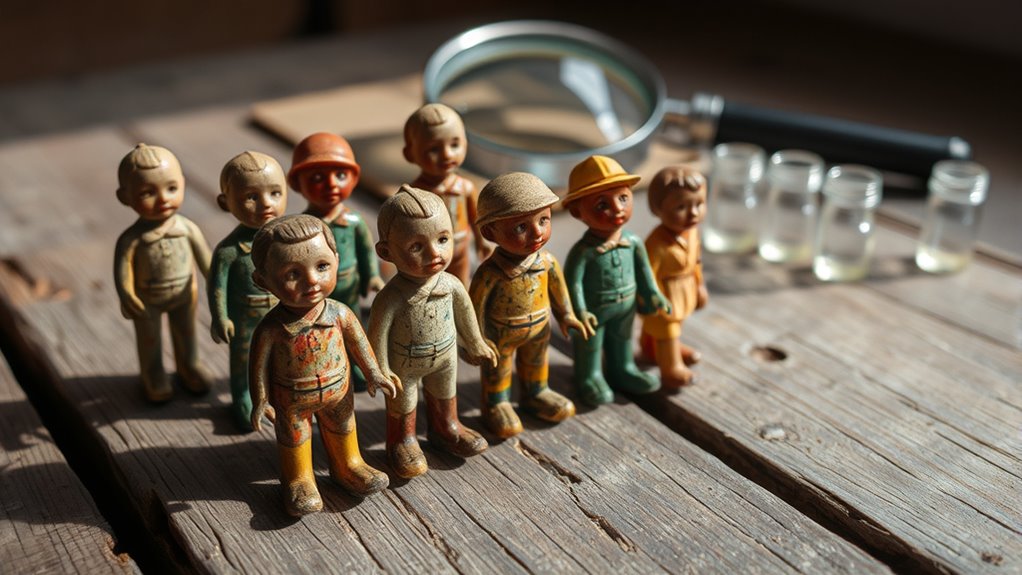To test vintage toys for lead dangers, start with a simple lead test kit available at hardware stores or online. Rub the swab on painted areas or packaging, following the instructions for quick results. For more accuracy, consider sending samples to a professional lab. If you’re concerned about safety, learning about testing methods and renovation options can help you keep your collectibles safe and enjoy them worry-free. Keep exploring to get the full picture.
Key Takeaways
- Use commercial lead test kits to quickly check paint or surface areas for lead presence.
- Send samples of paint or packaging to certified laboratories for accurate lead analysis.
- Examine vintage toys for chipped paint or discoloration that may indicate lead exposure.
- Prioritize replacing or restoring toys with confirmed or suspected lead to ensure safety.
- Handle vintage items carefully, wash hands after testing, and store safely to minimize lead risk.

Have you ever wondered if vintage toys might contain harmful levels of lead? It’s a valid concern, especially since many older toys were made before strict safety regulations were put into place. When you’re handling vintage toys, it’s essential to consider paint safety, as lead-based paint was commonly used in the past. This paint isn’t just a cosmetic issue; if it chips or wears off, children can accidentally ingest lead particles, posing serious health risks. Even if a toy appears clean and intact, the paint itself could be contaminated with lead, making it crucial to test before allowing kids to play with it.
Vintage toys may contain harmful lead paint; always test before letting children play.
Another aspect to keep in mind is vintage packaging. Sometimes, packaging from the same era as the toy might contain lead or other hazardous materials. Labels, inks, and adhesives used in older packaging often included lead-based compounds, which could leach into the toy or the environment around it. If you’re storing vintage toys in their original packaging or display cases, it’s wise to examine the packaging for signs of deterioration or discoloration, which can indicate the presence of hazardous substances. Handling vintage packaging with care and washing your hands afterward reduces the risk of exposure to any residual lead. Additionally, some vintage toys may have been manufactured with non-compliant materials, further increasing health risks. Understanding the manufacturing standards of that era can help you assess the risk more accurately.
Testing vintage toys for lead isn’t complicated, but it does require some diligence. You can purchase lead test kits from hardware or online stores, which are easy to use and provide quick results. These kits typically involve rubbing a test swab on the paint surface or packaging to determine if lead is present. For more accurate and comprehensive testing, especially if you suspect high levels or if the toy is of sentimental value, you might consider sending a sample to a professional lab. Professionals can analyze paint or materials more precisely, giving you peace of mind about safety. Additionally, understanding the presence of hazardous materials in vintage items can help you make informed decisions about preservation and display. Being aware of testing methods can also help you choose the most effective approach for your needs.
Being aware of the regulations surrounding vintage toys is also important, as it helps you understand what safety standards were or weren’t followed during manufacturing. While testing is a good step, prevention is better. If you’re unsure about a vintage toy’s safety, consider replacing or restoring it using lead-free paint or materials. Remember, just because a toy looks old or vintage doesn’t mean it’s safe. Always prioritize the safety of children and handle vintage items with care. By paying close attention to paint safety and vintage packaging, you can enjoy your collectibles without risking exposure to harmful lead. It’s a simple but essential step to ensure that old toys remain a source of joy rather than danger.
Frequently Asked Questions
Are Vintage Toys With Lead Safe to Display?
You might wonder if vintage toys with lead paint are safe to display. While they can be visually appealing, they often don’t meet current toy safety standards. Lead paint, especially in older toys, poses health risks. To protect yourself and others, it’s best to test vintage toys for lead before displaying them. If lead is detected, consider safe removal or display only in a way that minimizes contact, ensuring safety for everyone.
How Often Should I Test Vintage Toys for Lead?
Imagine a vintage toy sitting on your shelf, quietly hiding potential danger. You should test for lead regularly, ideally every year, to guarantee vintage toy safety. Lead testing frequency depends on the toy’s age, material, and history. By staying vigilant and testing consistently, you protect yourself and loved ones. Don’t wait until it’s too late—make testing part of your routine to keep your vintage collection safe and treasured.
Can You Remove Lead From Vintage Toys?
You can’t easily remove lead from vintage toys yourself, but you can improve toy safety by sealing or coating surfaces with lead-based paint. Lead elimination is complex and requires professional help to ensure thorough safety. To protect children, avoid toys with chipped paint or suspect markings. Always test vintage toys first, and if lead is present, consult a professional for proper lead removal methods to keep the toys safe for play.
What Are the Signs of Lead Poisoning From Toys?
Imagine your child’s tiny hands as a vintage radio, constantly exposed to potential lead hazards. Signs of lead poisoning from toys include irritability, weight loss, stomach pain, and developmental delays. Lead exposure threatens child safety, so it’s crucial to monitor symptoms and test vintage toys for lead before giving them to children. Act swiftly—early detection can prevent serious health issues and ensure your child’s well-being.
Are Vintage Toys With Lead Legal to Sell?
You might wonder if vintage collectibles with lead paint are legal to sell. Laws vary by location, but generally, toys containing lead paint are prohibited from sale due to health risks, especially for children. Vintage toys may contain lead paint, making testing essential. Before selling, you should have the toys tested for lead. If lead is present, it’s best to avoid selling or to clearly label and restrict their use to prevent exposure.
Conclusion
Don’t wait until it’s too late—test, verify, and guarantee safety. Don’t ignore the risks, dismiss the signs, or underestimate the danger. Take action now, educate yourself, and protect those you love. By testing thoroughly, by staying vigilant, and by making informed choices, you’re safeguarding health, preventing harm, and preserving joy. Because your vigilance matters, your awareness counts, and your proactive steps make all the difference in keeping vintage toys safe for everyone.









